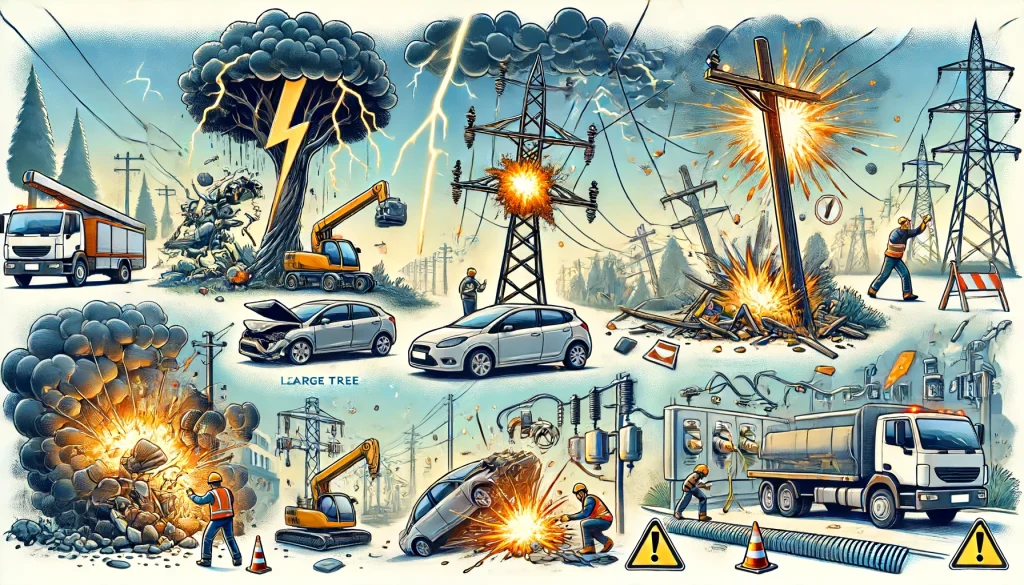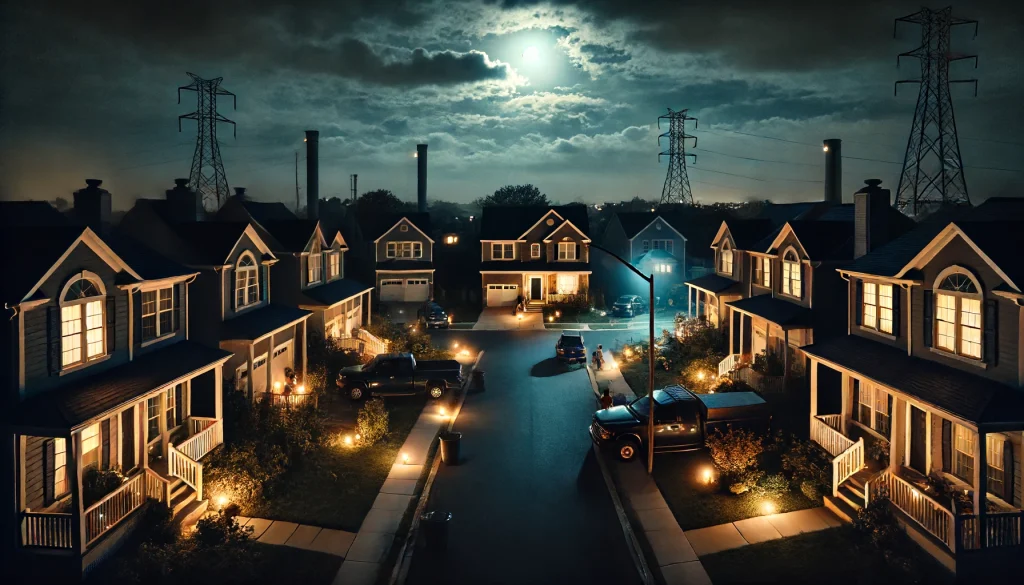Power outages can significantly impact daily life, halting industrial processes, disrupting communication, and posing safety risks. Severe weather remains the most common cause of these disruptions, but various other factors also contribute. Understanding the multiple causes of power outages provides a clearer picture of how and why they occur and helps develop strategies to prevent and mitigate them. So, what is the most common cause of power outage? learn the causes in this article.
What is the Most Common Cause of Power Outage
Here are some of the most common causes of power outage:
Weather-Related Causes
Storms (Thunderstorms, Hurricanes, Tornadoes)
Storms are the leading cause of power outages, as they can cause widespread and severe damage to power infrastructure. Thunderstorms bring heavy rain, lightning, and strong winds, all of which can damage power lines and transformers. Hurricanes are even more destructive, combining these elements over vast areas, leading to extensive and prolonged outages. Tornadoes, with their highly concentrated and intense wind speeds, can completely decimate power lines, poles, and substations in their paths, causing immediate and significant disruptions to the power supply.
High Winds
High winds, even in the absence of storms, pose a substantial risk to power lines and infrastructure. Gusts can blow debris into power lines, causing shorts and interruptions. Additionally, strong winds can uproot trees or break branches, which then fall onto power lines and equipment, leading to outages. Wind-related damage often requires extensive repair efforts to restore power, particularly if the infrastructure is widespread and the damage is severe.
Lightning Strikes
Lightning poses a direct threat to power infrastructure. When lightning strikes power lines, transformers, or substations, it can cause immediate and severe damage, leading to outages. Even when lightning strikes the ground near power infrastructure, the resulting power surges can travel through the ground and into the electrical system, causing damage and disruptions. The unpredictability of lightning makes it a particularly challenging cause of power outages to mitigate.
Snow and Ice Accumulation
Winter storms create unique challenges for power infrastructure. Snow and ice accumulation on power lines and trees can add significant weight, leading to breakages. The added stress on the lines can cause them to snap, while trees and branches weighed down by ice can fall onto power lines. Additionally, ice storms can create hazardous working conditions, making repair efforts more difficult and prolonging outages. The cumulative effect of snow and ice on power infrastructure often results in widespread and prolonged outages.
Flooding
Flooding, whether caused by heavy rains, storm surges, or other causes, can severely impact underground power systems and substations. Water intrusion into electrical equipment can cause immediate short-term and long-term damage, necessitating extensive repairs. Flooded substations can be particularly challenging to repair because they often require draining and thorough drying before any repairs can begin. In areas prone to flooding, power outages can be frequent and prolonged, affecting many customers.
Equipment Failure
Transformer Malfunctions
Transformers play a critical role in managing voltage levels within the power grid, ensuring that electricity is transmitted efficiently and safely from power plants to homes and businesses. When transformers malfunction, whether due to age, manufacturing defects, or other issues, they can cause significant disruptions to the power supply. Transformer malfunctions often require specialized repair or replacement, leading to prolonged outages, particularly if the affected transformer serves a large area.

Cable Faults
Cables, both overhead and underground, can develop faults for various reasons, including wear and tear, manufacturing defects, or physical damage. Overhead cables are particularly vulnerable to damage from weather, falling trees, and other external factors, while underground cables can be damaged by excavation activities or water intrusion. Locating and repairing cable faults can be challenging and time-consuming, especially if the affected cables are buried deep underground or are located in hard-to-reach areas.
Aging Infrastructure
Many regions rely on aging power infrastructure that is overdue for replacement. Older equipment is more prone to failure, especially under stress from high demand, severe weather conditions, or both. Aging transformers, cables, and other components may not perform as reliably as newer equipment, increasing the risk of outages. Upgrading aging infrastructure is a critical but often costly and time-consuming process that requires significant investment and planning.
Substation Failures
Substations are critical nodes in the power distribution network, stepping down high-voltage electricity from transmission lines to lower voltages suitable for local distribution. Failures at substations, whether due to equipment malfunction, physical damage, or other factors, can cut off power to large areas, leading to widespread outages. Substation failures often require specialized knowledge and equipment to repair, making them particularly challenging to address quickly.
Generator Issues
Problems with power plants or backup generators, whether due to mechanical failure, fuel supply issues, or other factors, can lead to power outages. Power plants generate electricity for the grid, and any disruption in their operation can affect many customers. Backup generators are designed to provide power during outages, but they can fail due to mechanical issues, lack of fuel, or improper maintenance, leaving critical facilities without power.
Human Error
Operational Mistakes
Human error during routine operations can lead to power outages. These errors can include switching errors, misconfigurations, or accidental shut-offs, and even small mistakes can have significant ripple effects throughout the power grid. Ensuring that operators are well-trained and follow established protocols is essential for minimizing the risk of outages caused by human error.

Construction Accidents
Construction activities, including excavations and other groundworks, can inadvertently damage power lines, especially underground cables. These accidents can cause immediate power outages and may require extensive repair efforts to restore service. Construction-related outages highlight the importance of careful planning and coordination between construction crews and utility companies to avoid accidental damage to power infrastructure.
Improper Maintenance
Regular maintenance is crucial for ensuring the reliability of the power grid. However, failure to perform proper or improper maintenance can result in equipment failures and power outages. Utility companies must adhere to strict maintenance schedules and protocols to ensure that all power grid components are functioning correctly and are less likely to fail under stress.
Excavation Damage
Digging operations can sever underground power cables without proper precautions, whether for construction, landscaping, or other purposes. These incidents, often called “dig-ins,” can cause immediate power outages and may require extensive and costly repairs to restore service. To prevent excavation damage, utility companies often provide location services to mark underground cables before digging begins.
Inadequate Training
Inadequate training of personnel can lead to mistakes that cause power outages. Ensuring that workers are properly trained in the operation and maintenance of power infrastructure is critical for maintaining a reliable power supply. Continuous training and development programs can help minimize the risk of outages caused by human error.
Wildlife Interference
Birds
Birds can cause power outages by nesting on power lines or equipment, leading to short circuits and other issues. Large flocks of birds can also create enough physical interference to disrupt power lines. Utility companies often use various deterrents, such as bird spikes or sonic devices, to prevent birds from nesting on or near critical power infrastructure.
Squirrels
Squirrels are notorious for causing power outages by chewing on power lines and equipment. Their small size and agility allow them to access critical components and cause damage that can lead to outages. To mitigate this risk, utility companies may install protective coverings or barriers to keep squirrels away from sensitive equipment.
Insects
Insect infestations, such as ants, bees, or wasps, can damage electrical equipment by building nests inside transformers, substations, or other components. The presence of insects can cause shorts, overheating, and other issues that lead to power outages. Regular inspections and pest control measures are necessary to prevent insect-related outages.
Rodents
Rats and mice can gnaw on insulation and wires, causing short circuits and other damage to the power infrastructure. Rodents are attracted to the warmth and shelter provided by electrical equipment, making them a common cause of outages. Utility companies may use rodent-proofing measures, such as sealing entry points and using rodent repellents, to protect their infrastructure.
Snakes
Snakes can enter substations and other electrical facilities, causing short circuits and equipment failures. These incidents are relatively rare but can be challenging to prevent due to the snakes’ ability to squeeze through small openings. Utility companies may use physical barriers and regular inspections to minimize the risk of snake-related outages.
Planned Outages and Maintenance
Scheduled Maintenance
Utility companies regularly schedule maintenance to ensure the reliability of the power grid. These planned outages are necessary for tasks such as inspecting and repairing equipment, upgrading infrastructure, and performing safety checks. While these outages are typically communicated in advance to minimize disruption, they are essential for preventing unplanned outages caused by equipment failure.

Infrastructure Upgrades
Upgrading aging infrastructure or expanding the power grid to meet growing demand can require temporary power outages. These upgrades are necessary to maintain and improve the reliability of the power supply, but they can cause temporary inconvenience for customers. Utility companies strive to schedule these upgrades during off-peak times to minimize the impact on customers.
Safety Checks
Regular safety inspections and tests are necessary to ensure the integrity of the power grid. These activities can sometimes necessitate brief outages to allow workers to safely inspect and test equipment. Safety checks help prevent more significant outages by identifying and addressing potential issues before they result in failures.
Tree Trimming
Maintaining clearances around power lines by trimming trees can help prevent outages caused by falling branches. However, the trimming process itself can sometimes require temporary outages to ensure the safety of workers and to prevent accidental damage to power lines. Utility companies often conduct tree trimming on a regular schedule to minimize the risk of outages caused by vegetation.
System Testing
Testing new systems or components, or conducting stress tests on the grid, can cause brief interruptions in the power supply. These tests are necessary to ensure that new installations and upgrades are functioning correctly and identify any potential system weaknesses. Planned testing is typically scheduled during periods of low demand to minimize disruption to customers.
Vandalism and Theft
Copper Theft
Copper theft from power lines and substations is a significant problem. Thieves often target copper wiring because of its high resale value, but the removal of copper wiring can disrupt electrical systems and cause outages. Utility companies have implemented various measures to combat copper theft, including using alternative materials, installing security cameras, and collaborating with law enforcement to prosecute offenders.
Vandalism of Equipment
Deliberate damage to power infrastructure, whether for vandalism or sabotage, can cause outages and pose safety risks. Vandalism can include cutting power lines, damaging transformers, or tampering with substations. Utility companies invest in security measures, such as fencing, surveillance systems, and alarm systems, to protect their infrastructure from vandalism.
Cyber Attacks
As power grids become more reliant on digital technology, they become vulnerable to cyber attacks. Hackers can infiltrate the power grid’s control systems and disrupt operations, leading to outages. Utility companies must invest in robust cybersecurity measures, including firewalls, encryption, and regular security audits, to protect against cyber threats.
Physical Security Breaches
Unauthorized access to power facilities can lead to intentional damage or theft, resulting in power outages. Physical security breaches can be prevented through measures such as perimeter fencing, access control systems, and security personnel. Ensuring that only authorized personnel can access critical infrastructure is essential for maintaining the security of the power grid.
Sabotage
Intentional sabotage of power systems, whether for political, economic, or other reasons, can cause widespread and prolonged outages. Sabotage can take many forms, including physical damage to infrastructure, cyber attacks, or other malicious actions. Utility companies work closely with law enforcement and other agencies to prevent and respond to sabotage threats.
Overload on the Power Grid
High Demand Periods
Periods of high electricity demand, such as during heat waves when air conditioning use spikes, can strain the power grid and lead to outages. During these times, the grid may struggle to supply enough power to meet the increased demand, resulting in rolling blackouts or brownouts. Utility companies may implement demand-response programs to encourage customers to reduce their electricity use during peak periods.
Heat Waves
Extended periods of high temperatures increase electricity use and stress the power grid, sometimes leading to rolling blackouts or brownouts. The increased use of air conditioning during heat waves places a significant load on the grid, which can result in equipment failures and outages. Utility companies often issue advisories and implement measures to manage the increased demand during heat waves.
Sudden Demand Surges
Unexpected spikes in electricity demand, whether from industrial activities, special events, or other causes, can overwhelm the grid and cause outages. Sudden demand surges can create imbalances in the power supply, leading to voltage drops or equipment failures. Utility companies monitor demand patterns and implement strategies to manage unexpected surges in electricity use.
Inefficient Energy Distribution
Poorly managed distribution systems can lead to localized outages, especially in areas where infrastructure is lacking or outdated. Inefficient energy distribution can result from imbalances in the grid, inadequate infrastructure, or poor maintenance practices. Utility companies work to optimize energy distribution and invest in infrastructure improvements to ensure reliable power delivery.
Insufficient Capacity
In some regions, the power grid’s capacity may not be sufficient to meet growing demand, leading to regular outages as the system is overloaded. Insufficient capacity can result from a lack of investment in infrastructure, rapid population growth, or increased industrial activity. Addressing capacity issues requires significant investment in new power generation and distribution infrastructure.

